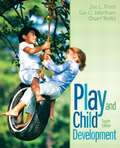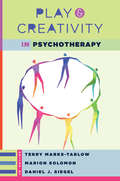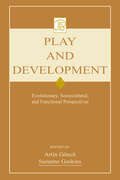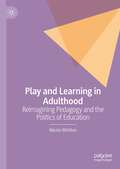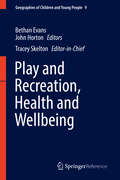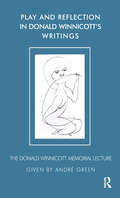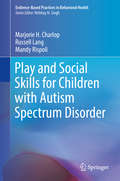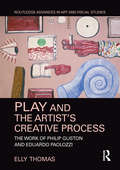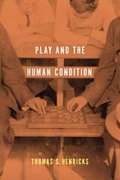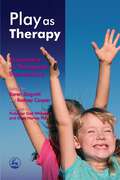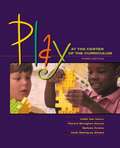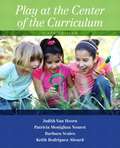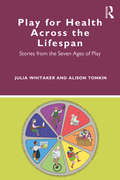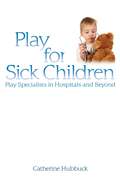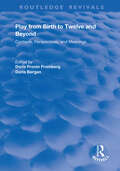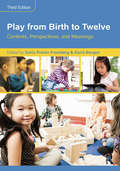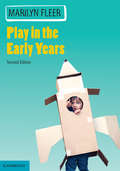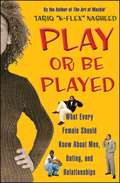- Table View
- List View
Play and Child Development Fourth Edition
by Sue C. Wortham Joe L. Frost Stuart ReifelMore than any other textbook on the market, Play and Child Development, Fourth Edition, ties play directly to child development. The authors address the full spectrum of play-related topics and seamlessly blend research, theory, and practical applications throughout this developmentally-based resource. Readers will learn about historical, theoretical, and practical approaches to promoting development through integrated play and learning approaches across various age or developmental levels. The book analyzes play theories and play therapy; presents a history of play; and discusses current play trends. It explores ways to create safe play environments for all children, and how to weave play into school curricula. Finally, the authors examine the role of adults in leading and encouraging children's natural tendencies toward learning by playing. Special coverage includes a full chapter on play and children with disabilities, and the value of field trips in supporting learning. This edition offers expanded and/or updated coverage on evidence based play theory, child development, play environments, and early play-based curricula for children of all abilities in various learning contexts. All content in the text is purposefully arranged to guide its readers through key and core topics leading to a comprehensive understanding of play intended to help prepare pre-service teachers to lead and support children's play in a number of contexts: preschools, elementary schools, park systems, and research programs.
Play and Creativity in Psychotherapy (Norton Series on Interpersonal Neurobiology #0)
by Daniel J. Siegel Marion Solomon Terry Marks-TarlowDistinguished clinicians demonstrate how play and creativity have everything to do with the deepest healing, growth, and personal transformation. Through play, as children, we learn the rules and relationships of culture and expand our tolerance of emotions—areas of life "training" that overlap with psychotherapy. Here leading writers illuminate what play and creativity mean for the healing process at any stage of life. Contributors include: Mihály Csíkszentmihályi, Daniel J. Siegel, Marion Solomon, Aldrich Chan, Allan Schore, Terry Marks-Tarlow, Pat Ogden, Louis Cozolino, Theresa Kestly, Jaak Panksepp, Stuart Brown, Madelyn Eberly, Zoe Galvez, Betsy Crouch, Bonnie Goldstein, and Steve Gross.
Play and Development: Evolutionary, Sociocultural, and Functional Perspectives (Jean Piaget Symposia Ser.)
by Artin Göncü Suzanne GaskinsChildren's play is a universal human activity, and one that serves a significant purpose in personal development.Throughout this volume, which is an extension of the 33rd Annual Meeting of the Jean Piaget Society, the editors and contributors explore assumptions about play and its status as a unique and universal activity in humans.As a whole, Play
Play and Exploration in Children and Animals
by Thomas G. PowerPlay is a paradox. Why would the young of so many species--the very animals at greatest risk for injury and predation--devote so much time and energy to an activity that by definition has no immediate purpose? This question has long puzzled students of animal behavior, and has been the focus of considerable empirical investigation and debate. In this first comprehensive and state-of-the-art review of what we have learned from decades of research on exploration and play in children and animals, Power examines the paradox from all angles. Covering solitary activity as well as play with peers, siblings, and parents, he considers the nature, development, and functions of play, as well as the gender differences in early play patterns. A major purpose is to explore the relevance of the animal literature for understanding human behavior. The nature and amount of children's play varies significantly across cultures, so the author makes cross-cultural comparisons wherever possible. The scope is broad and the range multidisciplinary. He draws on studies by developmental researchers in psychology and other fields, ethologists, anthropologists, sociologists, sociolinguists, early childhood educators, and pediatricians. And he places research on play in the context of research on such related phenomena as prosocial behavior and aggression. Finally, Power points out directions for further inquiry and implications for those who work with young children and their parents. Researchers and students will find Play and Exploration in Children and Animals an invaluable summary of controversies, methods, and findings; practitioners and educators will find it an invaluable compendium of information relevant to their efforts to enrich play experiences.
Play and Learning in Adulthood: Reimagining Pedagogy and the Politics of Education
by Nicola WhittonThis book provides a theoretical and philosophical examination of games, play and playfulness and their relationships to learning and wellbeing in adulthood. It draws on an interdisciplinary literature base (including game-based learning, game studies, education, psychology, and game design) to present a critical manifesto for playful learning in post-compulsory education and lifelong learning. While there is an established body of work in games and learning in adulthood, and a wide literature on the value of play in childhood, the wider potential of play in adulthood and playfulness is under-explored and still emergent. This book offers a comprehensive overview of play in adulthood, exploring the benefits and drawbacks, examining why play in adulthood is different from play in childhood, the role of play in culture, and making an argument for why it is important in our society that we embrace the principles of playfulness.
Play and Power (The\efpp Monograph Ser.)
by Karen Vibeke Mortensen Liselotte GrünbaumThe power of play, so central to psychoanalytic theory and practice, is conjoined to the social psychological or socio-politically coloured concept of power, giving rise to many fruitful discussions of how these concepts manifest themselves in clinical work with children, groups and adults. The inspiration for this book was the 3-section EFPP conference in Copenhagen in May 2007 with the main theme "Play and Power". At the conference and in the book, this theme is presented both inside and outside the therapeutic space. It is amply illustrated in clinical cases from individual psychotherapies with children and adults and from group analysis. Most of the examples are with hateful or resigned children and adults who have been exposed to extremely damaging or unhelpful environments, and who demonstrate convincingly some of the devastating consequences that abuse of power in the real world may have. Play and power are also explored in the broader context of the community, however.
Play and Recreation, Health and Wellbeing
by John Horton Tracey Skelton Bethan EvansGeographies of children and young people is a rapidly emerging sub-discipline within human geography. There is now a critical mass of established academic work, key names within academia, growing numbers of graduate students and expanding numbers of university level taught courses. There are also professional training programmes at national scales and in international contexts that work specifically with children and young people. In addition to a productive journal of Children's Geographies, there's a range of monographs, textbooks and edited collections focusing on children and young people published by all the major academic presses then there is a substantive body of work on younger people within human geography and active authors and researchers working within international contexts to warrant a specific Major Reference Work on children's and young people's geographies. The volumes and sections are structured by themes, which then reflect the broader geographical locations of the research.
Play and Reflection in Donald Winnicott's Writings (The Donald Winnicott Memorial Lecture Series)
by Andre GreenThe third book in the Winnicott Clinic Lecture Series contains a lecture from the author on Winnicott's theory on play. He discusses Winnicott's view on the importance of play and then moves on to presenting his own, somewhat contradictory, view on it. The author provides an innovative and provocative perspective on the subject, inviting people to think independently rather than accepting theories already laid out for them.
Play and Social Skills for Children with Autism Spectrum Disorder (Evidence-based Practices In Behavioral Health Ser.)
by Russell Lang Marjorie H. Charlop Mandy RispoliThis book discusses the deficits in the development and presentation of play behavior and social skills that are considered central characteristics of autism spectrum disorder (ASD). The book explains why play provides an important context for social interactions and how its absence can further exacerbate social deficits over time. It highlights the critical roles of social skills in development, and the social, cognitive, communication, and motor components of play. Chapters offer conceptually and empirically sound play and social skills interventions for children with ASD. Play activities using diverse materials and including interactions with peers and parents are designed to promote positive, effective social behaviors and encourage continued development. The book provides unique strategies that can be tailored to fit individual children’s strengths and deficits.Topics featured in this book include:Naturalistic Teaching Strategies (NaTS) for developing play and social skills. Teaching play and social skills with video modeling. Peer-mediated intervention (PMI) strategies that promote positive social interactions between children with ASD and their peers. Visual Activity Schedules and Scripts. Parent-implemented play and social skills intervention.Play and Social Skills for Children with Autism Spectrum Disorder is a must-have resource for researchers, clinicians, and graduate students in clinical child and school psychology, behavioral therapy/rehabilitation, social work, public health, and related psychology, education, and behavioral health fields.
Play and the Artist’s Creative Process: The Work of Philip Guston and Eduardo Paolozzi (Routledge Advances in Art and Visual Studies)
by Elly ThomasPlay and the Artist’s Creative Process explores a continuity between childhood play and adult creativity. The volume examines how an understanding of play can shed new light on processes that recur in the work of Philip Guston and Eduardo Paolozzi. Both artists’ distinctive engagement with popular culture is seen as connected to the play materials available in the landscapes of their individual childhoods. Animating or toying with material to produce the unforeseen outcome is explored as the central force at work in the artists’ processes. By engaging with a range of play theories, the book shows how the artists’ studio methods can be understood in terms of game strategies.
Play and the Human Condition
by Thomas S. HenricksIn Play and the Human Condition, Thomas Henricks brings together ways of considering play to probe its essential relationship to work, ritual, and communitas. Focusing on five contexts for play--the psyche, the body, the environment, society, and culture--Henricks identifies conditions that instigate play, and comments on its implications for those settings. Offering a general theory of play as behavior promoting self-realization, Henricks articulates a conception of self that includes individual and social identity, particular and transcendent connection, and multiple fields of involvement. Henricks also evaluates play styles from history and contemporary life to analyze the relationship between play and human freedom. Imaginative and stimulating, Play and the Human Condition shows how play allows us to learn about our qualities and those of the world around us--and in so doing make sense of ourselves.
Play as Therapy: Assessment and Therapeutic Interventions
by Steve Harvey Virginia Ryan Ann Cattanach Rodney Cooper Ted Brown Karen Stagnitti Gail Whiteford Tina Lautaumo Athena Drewes Reinie Cordier Anita Bundy Rachael Mcdonald Susan Esdaile Jennifer Sturgess Judi ParsonWhile paediatric healthcare professionals view play as the treatment tool of choice for children under school age, the theory and practice underpinning play-based therapeutic approaches often remain less clear to individual practitioners. Paediatric intervention approaches are increasingly being questioned, and individual practitioners constantly asked to provide evidence-based practice. In response, a more coherent understanding and fresh discussion on children's play and utilisation of play for therapeutic purposes is needed, especially as societal expectations and lifestyles change. Play as Therapy provides background theory and practical applications of original research on play assessment and interventions used in therapy. The book offers a solid foundation for identifying and assessing play dysfunction, understanding play in different cultural contexts and considerations when intervening with play. The practical approach is underpinned by theory, research and case vignettes to explain how to utilise play as therapy with challenging children.
Play at the Center of the Curriculum
by Judith Van Hoorn Patricia Monighan Nourot Barbara Scales Keith Rodriquez AlwardThis book for future early childhood educators offers all of the background needed to plan and implement a developmentally appropriate, play-centered curriculum for children ages 3 to 8.
Play at the Center of the Curriculum
by Judith Van Hoorn Patricia Monighan Nourot Barbara Scales Keith Rodriguez AlwardThe leading text in the field, Play at the Center of the Curriculum seamlessly combines the features of a text on play and development with the features of an early childhood curriculum text to present a comprehensive, cogent rationale for placing play at the center of a balanced curriculum. Ideal for those who want to engage children in a developmental zone where children and teachers are learning from and with each other, the authors put play at the center of a balanced curriculum that includes spontaneous, guided, and directed play as well as teacher planned instruction. They describe how knowledgeable teachers use a wide repertoire of strategies to orchestrate the flow from spontaneous play to guided play, to more subject oriented instruction, and back to play. This thoroughly updated Sixth Edition interweaves anecdotes of children’s play, theories of play and development, empirical evidence from research, and practical instructional strategies to give students a clear look at play and the curriculum.
Play for Health Across the Lifespan: Stories from the Seven Ages of Play
by Alison Tonkin Julia WhitakerPlay for Health Across the Lifespan uses case studies to explore the impact of play and creativity on health and wellbeing throughout the lifecycle. While play at the start of life influences future development, the authors show play also has a role in improving prospects for health and wellbeing in adulthood and later life. A relational approach to health and wellbeing emphasizes the dynamic, mutually influential relationship between individual development and the changing contexts of our lives. Our personal play history is one feature of this dynamic process, and this book explores how the experience of play throughout the life course sculpts and resculpts the shape of our lives: our physical health, our mental wellbeing, and our relationship to the people and the world around us. Storytelling has been used since the beginning of time to communicate important life lessons in an engaging way. Taking inspiration from Shakespeare’s ‘Seven Ages of Man’, the book uses a case-story approach to differentiate the stages of development and to present evidence for how play and playful experiences impact on health and wellbeing from birth to the end of life in the context of temporal and situational change. Each chapter in Play for Health Across the Lifespan introduces relevant evidence-based research on play and health, before presenting several narrative ‘case stories’, which illustrate the application of play theory and the neuroscience of play as they relate to each life stage. With contributions from specialists in health and education, community organizations and the creative and performing arts, this book will appeal to academics, students, and practitioners who are interested in exploring the role of play in addressing contemporary challenges to our physical, mental, and social health.
Play for Sick Children: Play Specialists in Hospitals and Beyond
by Cath HubbuckPlay for Sick Children offers a unique insight into the crucial work of the play specialist. It examines the repercussions of being ill and receiving treatment experienced by children and their families, and highlights the importance of receiving quality play opportunities to counter these negative effects. The author proposes that play should be a high priority for those working in hospitals and other healthcare settings, and challenges other professionals to acknowledge, understand, accept and value the play specialist's role within the multidisciplinary team. The book explores the history of play in hospital, outlines the basic techniques and practical approaches used in working with sick children and young people, and identifies and discusses key theoretical and practical elements of the ever-changing role of the play specialist. This all-encompassing resource will be of great value to the ever growing and dedicated community of professionals who provide play, information and emotional support for sick children and their families.
Play from Birth to Twelve: Contexts, Perspectives, and Meanings
by Doris Pronin FrombergFirst published in 1998. Play is pervasive, infusing human activity throughout the life span. In particular, it serves to characterize childhood, the period from birth to age twelve. Within the past twenty years, many additions to the knowledge base on childhood play have been published in popular and scholarly literature. This book assembles and integrates this information, discusses disparate and diverse components, highlights the underlying dynamic processes of play, and provides a forum from which new questions may emerge and new methods of inquiry may develop. The place of new technologies and the future of play in the context of contemporary society also are discussed.
Play from Birth to Twelve: Contexts, Perspectives, and Meanings
by Doris Pronin Fromberg and Doris BergenIn light of recent standards-based and testing movements, the issue of play in child development has taken on increased meaning for educational professionals and social scientists. This third edition of Play From Birth to Twelve offers comprehensive coverage of what we now know about play and its guiding principles, dynamics, and importance in early learning. These up-to-date essays, written by some of the most distinguished experts in the field, help educators, psychologists, anthropologists, parents, health service personnel, and students explore a variety of theoretical and practical ideas, such as: all aspects of play, including historical and diverse perspectives as well as new approaches not yet covered in the literature how teachers in various classroom situations set up and guide play to facilitate learning how play is affected by societal violence, media reportage, technological innovations, and other contemporary issues play and imagination within the current scope of educational policies, childrearing methods, educational variations, cultural differences, and intellectual diversity New chapters in the third edition of Play From Birth to Twelve cover current and projected future developments in the field of play, such as executive function, neuroscience, autism, play in museums, "small world" play, global issues, media, and technology. The book also suggests ways to support children’s play across different environments at home, in communities, and within various institutional settings.
Play in Child Development and Psychotherapy: Toward Empirically Supported Practice
by Sandra Walker RussChild psychotherapy is in a state of transition. On the one hand, pretend play is a major tool of therapists who work with children. On the other, a mounting chorus of critics claims that play therapy lacks demonstrated treatment efficacy. These complaints are not invalid. Clinical research has only begun. Extensive studies by developmental researchers have, however, strongly supported the importance of play for children. Much knowledge is being accumulated about the ways in which play is involved in the development of cognitive, affective, and personality processes that are crucial for adaptive functioning. However, there has been a yawning gap between research findings and useful suggestions for practitioners. Play in Child Development and Psychotherapy represents the first effort to bridge the gap and place play therapy on a firmer empirical foundation. Sandra Russ applies sophisticated contemporary understanding of the role of play in child development to the work of mental health professionals who are trying to design intervention and prevention programs that can be empirically evaluated. Never losing sight of the complex problems that face child therapists, she integrates clinical and developmental research and theory into a comprehensive, up-to-date review of current approaches to conceptualizing play and to doing both therapeutic play work with children and the assessment that necessarily precedes and accompanies it.
Play in Clinical Practice
by Sandra Russ Larissa NiecGoing beyond traditional play therapy, this innovative book presents a range of evidence-based assessment and intervention approaches that incorporate play as a key element. It is grounded in the latest knowledge about the importance of play in child development. Leading experts describe effective strategies for addressing a wide variety of clinical concerns, including behavioral difficulties, anxiety, parent child relationship issues, trauma, and autism. The empirical support for each approach is summarized and clinical techniques are illustrated. The book also discusses school-based prevention programs that utilize play to support children's learning and social-emotional functioning.
Play in Family Therapy
by Eliana GilThis classic volume, now completely revised, has helped tens of thousands of therapists integrate play therapy and family therapy techniques in clinical practice. Eliana Gil demonstrates a broad range of verbal and nonverbal strategies for engaging all family members--including those who are ambivalent toward therapy--and tailoring interventions for different types of presenting problems. Numerous case examples illustrate ways to effectively use puppets, storytelling, art making, the family play genogram, drama, and other expressive techniques with children, adolescents, and their parents. Gil offers specific guidance for becoming a more flexible, creative practitioner and shows how recent advances in neuroscience support her approach. Photographs of client artwork are included.
Play in the Early Years
by Marilyn FleerThe Early Years Learning Framework is a key component of the Australian Government's National Quality Framework for early childhood education and care. Play-based learning is an important focus in both the Framework and in early childhood education degrees at Australian universities. Play in the Early Years is a comprehensive study of pedagogy and play in early childhood education by a globally recognised leader in the field. Marilyn Fleer examines how play has been thought about across time, culture and institutions, including in childcare, family day care, schools and community groups. The book presents and analyses the latest research and theories about early childhood pedagogy and play. Vignettes and real-world examples help students connect theory to practice, while end-of-chapter glossaries help to consolidate understanding of key concepts and ideas. This is an accessible and engaging textbook that will be an invaluable resource for practitioners and undergraduate students of early childhood education.
Play in the Early Years
by Marilyn FleerThe Early Years Learning Framework is a key component of the Australian Government's National Quality Framework for early childhood education and care. Play-based learning is an important focus in both the Framework and in early childhood education degrees at Australian universities. Play in the Early Years is a comprehensive study of pedagogy and play in early childhood education by a globally recognised leader in the field. Marilyn Fleer examines how play has been thought about across time, culture and institutions, including in childcare, family day care, schools and community groups. The book presents and analyses the latest research and theories about early childhood pedagogy and play. Vignettes and real-world examples help students connect theory to practice, while end-of-chapter glossaries help to consolidate understanding of key concepts and ideas. This is an accessible and engaging textbook that will be an invaluable resource for practitioners and undergraduate students of early childhood education.
Play is a Feeling (Psychology Revivals)
by Brenda CroweOriginally published in 1983, Play is a Feeling is an exploration of the world of childhood, those first discoveries of sensation, movement, language and surroundings that are an essential part of the process through which children learn and develop. Brenda Crowe, with her amazing gift for recalling and interpreting the feelings of childhood, describes the nature of children’s fears, comforts, joy and distress which are expressed through play. At once stimulating and reassuring, this is a book that will stir memories and help many parents look at themselves and their children with fresh insight.
Play or Be Played
by Tariq "K-Flex" NasheedGot Game? It's a fact. Every woman needs game. Take Oprah, Jada Pinkett-Smith, and Beyoncé Knowles. All three of these women have the one intangible quality that every mack, male or female, must possess: they all have game. In other words, they have intelligence, hustle, and common sense that they apply to every aspect of their lives -- especially in their relationships. Play or Be Played is an instruction manual for women who are tired of being played by men and who want to be players themselves. Though women may not want to play games, the truth is men often do. So women who hope to win in the game of love must first learn the rules. Bestselling author and true mack, Tariq "K-Flex" Nasheed shares: ways to spot a scrub what it takes to get with a baller why men cheat how men really judge women the top three mistakes women make in relationships Street-smart and straightforward, Play or Be Played will help you get with a king without being a hoochie, groupie, or a chickenhead.
